
What is a terminal, and what are the types of battery terminals
Content
- What is a terminal
- Functions
- Terminal types
- Dimensions and applicability of battery terminals
- Which terminals to choose?
- Why are the battery terminals being oxidized?
- How to prevent oxidation?
- How to get rid of terminal oxidation?
- Why are the terminals on the battery heated?
- Do I need to lubricate the battery terminals?
- What means to use to protect the terminals of car batteries?
- How to replace the battery terminal
- Related videos
- Questions and answers:
What is a terminal
The terminal is a kind of clamping device. Its purpose is to provide a solid connection between the two ends of the wiring between themselves or on a power source. In connection with automobiles, battery terminals are most often referred to.
They are made of metals with high current conductivity. The stability of the electronics depends on the quality of these elements. Due to the constant exposure to moisture in the air, they can oxidize.
What are the terminals and how to protect them from oxidation?
Functions
Despite the simplicity of the design, the battery terminal plays an important role in the vehicle's electrical system. It allows you to power any consumer from a battery. For different types of vehicles, different terminal modifications are used, which allows the use of different batteries.
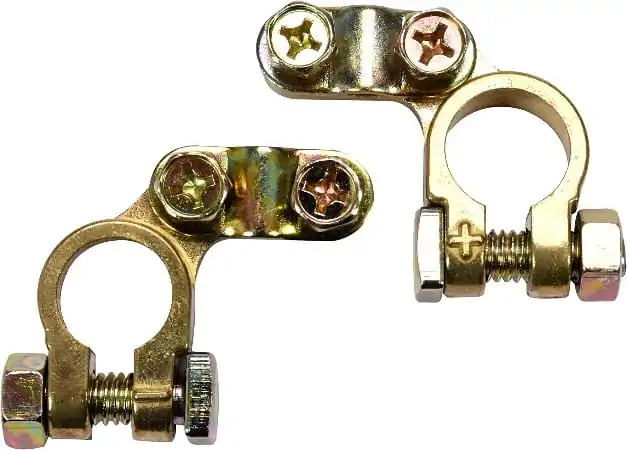
Most terminals are of a bolted clamp design. This option provides the strongest possible connection between the wires and the battery, which eliminates the possibility of sparking or excessive heating due to poor contact.
Terminal types
Types of battery terminals depend on:
- battery polarity;
- installation diagrams;
- forms of compound;
- material of manufacture.
Battery polarity
Car batteries give direct current. Therefore, when connecting an electrical circuit, it is extremely important to observe the polarity. Contact “+” cannot be directly connected to “-”.
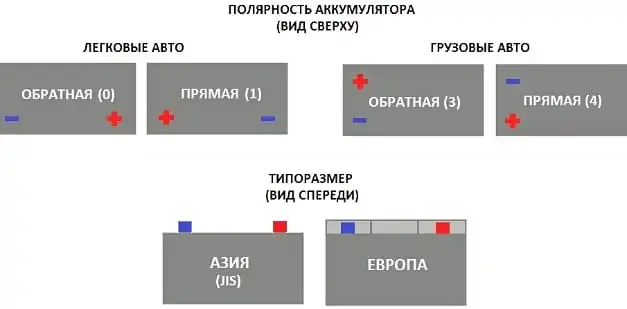
In batteries for passenger cars, the contacts are located on opposite sides of the case. Modifications for trucks are equipped with contacts on one side. All batteries differ in the arrangement of output contacts.
- Direct polarity. Such batteries are installed in domestic car brands. In them, the positive contact is on the left, and the negative contact is on the right (Figs. 1 and 4).
- Reverse polarity. In foreign cars, the option with the reverse (compared with the previous modification) contact arrangement (Fig. 0 and 3) is used.
On some batteries, the terminals are connected diagonally. The clamping contacts can be flat or curved to the side (to prevent accidental contact). You need to pay attention to their shape when using a battery with limited space near the contacts (Fig. Europe).
Wiring diagram
The most common wiring diagram for the electrical system is from the top of the battery. To prevent the motorist from accidentally reversing the polarity and spoiling the equipment, the battery contacts have different diameters. In this case, when connecting the wires, the owner of the car will not even be able to put a terminal on the output contact of the battery.
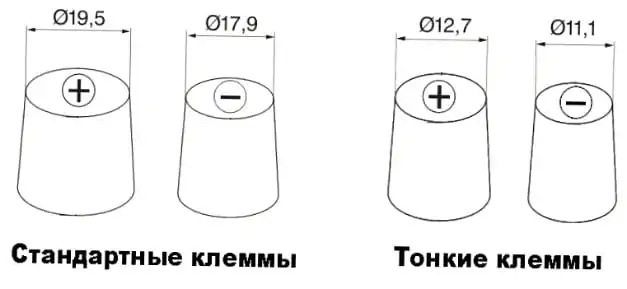
When buying a car abroad, you need to make sure that the battery in it has a European standard (and not Asian). If the terminal on such a battery fails (oxidizes or breaks), it will be difficult to find a replacement for it, and the battery will have to be replaced.
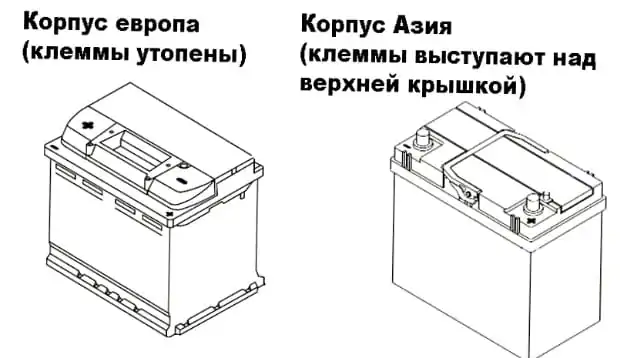
These types of batteries can have different sizes, and therefore not suitable for installation in the engine compartment. Therefore, cars for the Asian market are not sold in our region and vice versa.
Form and dimensions of conclusions
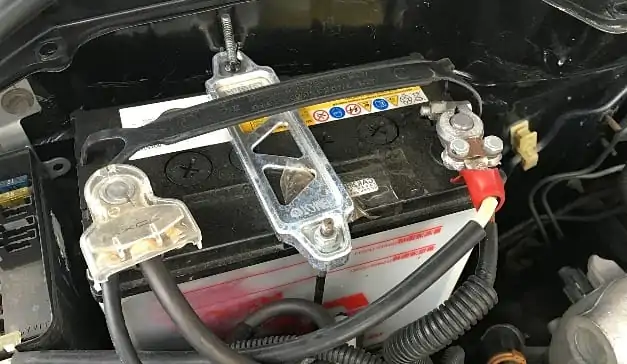
Before you buy a new pair of terminals, you need to pay attention to the shape of the battery contacts. Most automotive batteries sold in the CIS countries are equipped with cone-shaped contacts. Naturally, a flat terminal in this case will have a smaller contact area. As a result, a circuit break due to an oxidized compound.
The contacts of some batteries have a bolt clamp (options for trucks) or a screw (standard common in North America). You should pay attention to this when buying a car on American Internet sites.
If it happened that a motorist purchased a car with a non-standard battery connection, you can buy a special adapter for terminals or self-locking modifications.
Material of manufacture
In addition to the shape and type of the clamping part, battery terminals are made from different materials. The key parameters for selecting a material are mechanical strength, electrical conductivity and oxidation resistance. Consider the most popular materials from which the terminals are made, and their features.
Lead terminals
Most often, lead terminals are offered for a car battery. Their feature is the optimal price-quality ratio. This material is resistant to mechanical stress. Compared to copper and brass, lead has a lower electrical conductivity.
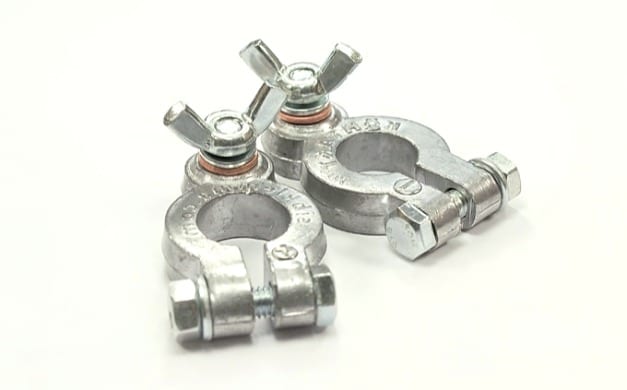
The main disadvantage of lead is its low melting point. But a terminal made of this metal will act as an additional fuse. If a short circuit is suddenly formed in the system, the material will melt, disconnecting the electrical circuit.
So that the terminals do not oxidize so much and have high performance, the bolted connection is treated with a special compound. Some types of terminals use brass lugs.
Brass terminals
Brass terminals are moisture resistant. They are easy to install. They are equipped with a bolt and nut (or wing) that do not oxidize for a long time. In addition to these advantages, brass has a significant disadvantage. This material is quite plastic, therefore it does not tolerate large mechanical loads. If you tighten the nut tightly, the terminal is easily deformed and quickly breaks.
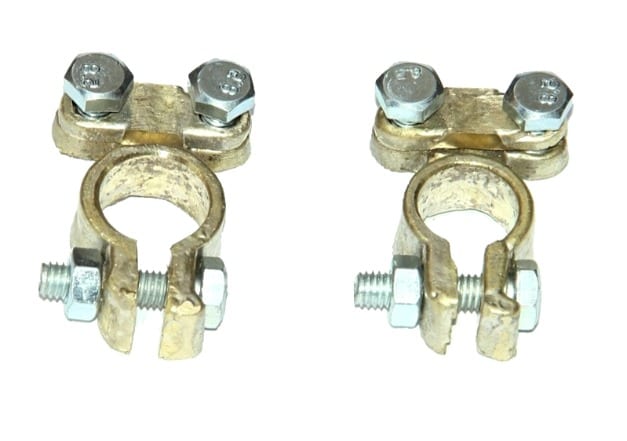
Copper terminals
This is one of the most expensive types of terminal blocks. In classical batteries, copper is rarely used, because the properties of brass or lead are sufficient (the main thing is to properly care for such terminals). The reason for the high cost of such parts is the complexity of the metal casting process. But if the car owner purchases copper terminals for his battery, then these elements will simplify the start of the motor in the winter, and will not oxidize.
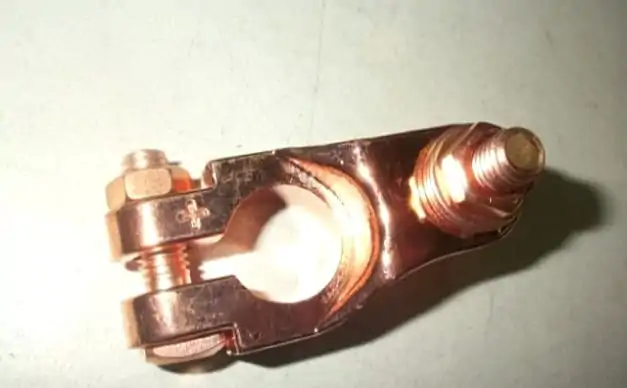
It is not uncommon to find copper-plated steel terminals in the auto parts market. This is not the same as the copper counterpart. This option has poorer performance characteristics. Such terminals can be distinguished by their cost: products made entirely of copper will be much more expensive.
Dimensions and applicability of battery terminals
So that an inexperienced car owner does not accidentally confuse the terminals in places when disconnecting / connecting the battery, the battery manufacturers made sure that they have different diameters.
There are two more common terminal sizes on the market:
- European standard (Type 1). In this case, the positive terminal has a diameter of 19.5 mm, and the negative terminal is 17.9 mm.
- Asian standard (Type 3). The diameter of such terminals for positive is 12.7, and for negative - 11.1 millimeters.
In addition to the diameter, an important parameter of automotive terminals is the cross-section of the wires for which they are intended. Standard terminals are designed for cross sections from 8 to 12 square millimeters. For wires with an increased cross-section, you will need special terminals.
Which terminals to choose?
The easiest option is to buy the type of terminal that is installed in the car at the factory. In this case, there will be no installation problems.
If it is necessary to replace the standard terminals due to their impracticality, then it is better to dwell on the lead version. They will cost less, and in terms of strength they are better than bronze and brass counterparts.
Copper is an ideal option because it oxidizes less and can be tightly clamped with bolts. However, they are more difficult to find and cost they will be much more expensive.
Why are the battery terminals being oxidized?
There are several reasons for this effect. So, the terminals of the storage battery can oxidize due to the leakage of the battery case. Also, this malfunction occurs in the event of a battery boiling or increased evaporation from the gas outlet.
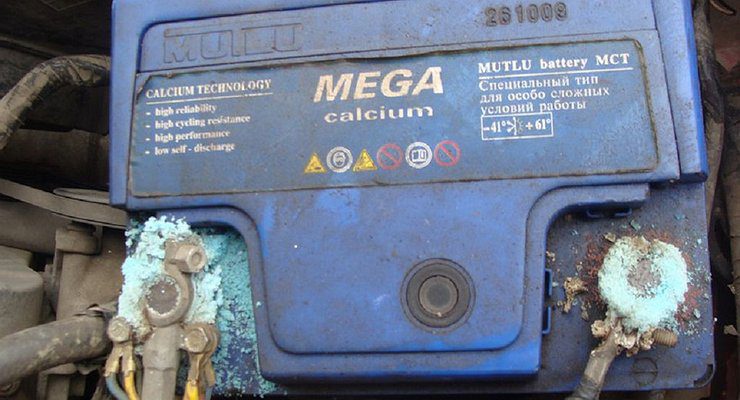
When electrolyte vapors leave the battery, they condense on the terminals, which is why a white coating appears on them. It leads to poor contact, terminal heating and other related troubles.
A violation of the tightness of the battery (between the down conductor and the case) is more common in budget options. If microcracks appear on the battery case, they need to be eliminated as soon as possible (you can use a regular glue gun, but in no case use a hair dryer, a soldering iron, etc.)
On more expensive batteries, the gas outlet and the conductive part are located in different parts of the battery case, due to which electrolyte vapors are freely removed from the battery during boiling, but at the same time they do not condense at the terminals.
How to prevent oxidation?
Regardless of the material, all terminals will sooner or later begin to oxidize. This is a natural process when exposed to moist metal. Due to poor contact on the battery, abrupt voltage surges can occur in the electrical system of the machine (this effect occurs when the voltage is restored and is often accompanied by sparking). To prevent expensive equipment from malfunctioning, it is necessary to regularly maintain contacts on the terminals.
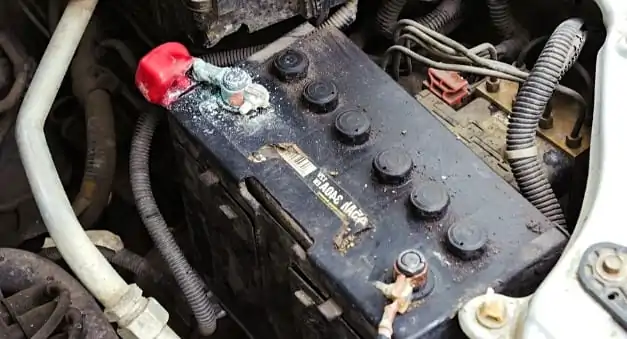
To do this, periodically disconnect them and remove plaque on the inside of the crimps. This procedure should be performed, even if the car is in a dry garage, because the formation of plaque may be due to a chemical reaction when the parts are heated and exposed to electricity.
Some motorists perform this procedure by loosening the fixing bolts a little and turning the terminal on the contact several times. These actions will help restore nutrition, but at the same time lead elements will become unusable faster. It is much better to clean the contacts with alcohol-soaked wipes.
So, battery terminals are a simple but important element in a car’s electrical circuit. With proper care and proper installation, they will ensure the stable operation of all machine equipment.
How to remove and then put on the terminals from the battery, see the following video:
How to get rid of terminal oxidation?
Every motorist fights this effect differently. There are a variety of terminal cleaners that can remove plaque from the terminal. Some car owners use sandpaper to make the contact surface of the terminals as smooth as possible for maximum contact area.
Instead of sandpaper, you can purchase a terminal cleaner. This is a special cone-shaped tool (also called a scraper or terminal brush) with a small brush that allows you to evenly grind the contact spot on the down conductor.
After using the tool, the resulting debris must be carefully collected, and the battery case should be washed with a solution of soda (it neutralizes the acid located on the battery case).
Why are the terminals on the battery heated?
This effect is natural for conductive elements that have poor contact with each other. A reduced contact area between the down conductor and the terminal can be due to one of the following reasons:
- Poorly clamped terminal (often observed with daily disconnection / connection of the battery without tightening the fastening bolts);
- Deformation of down conductors or terminals due to careless operation;
- Dirt has appeared on the contact surface of the terminals or down conductors (for example, they have oxidized).
The terminals get hot due to the high resistance between them and the down conductors due to poor contact. This effect is especially manifested at the start of the motor, since a high-power starting current passes through the wires. To overcome the lack of contact, some of the energy is used, which is immediately reflected in the operation of the starter. When starting the engine, even with a new battery, the starter may turn sluggishly.
This is due to the fact that it receives a starting current of less power. To eliminate this effect, it is enough to clean the down conductors and terminals from dirt or eliminate deformation. If the terminal is deformed, it is better to replace it with a new one.
Do I need to lubricate the battery terminals?
The terminals are lubricated to protect them from moisture and electrolyte vapors. In this case, the outer part of the terminals is processed, and not the contact surface. The reason is that there must be no foreign matter between the down conductor and the inside of the terminals.


Actually, for this reason, contact disappears during oxidation - a plaque forms between the conductive elements. Grease on the contact surface has the same effect. Plus, all terminal greases are non-conductive. For this reason, the terminals are processed after they are securely clamped on the battery down conductors.
Another point to consider. If the terminal is oxidized, it is useless to lubricate it - you must first remove the plaque. The grease prevents rapid oxidation of the terminals, but does not neutralize plaque buildup.
What means to use to protect the terminals of car batteries?
Modern means of preventing oxidation of the terminals are recommended as additional protection (for example, if it is not possible to quickly replace a cracked battery). Such substances can cost a lot of money. Previously, motorists used LITOL24 or any other lubricant for this, the main thing is that it is thick.
Popular tools that can be used to lubricate battery terminals today are:
- Molykote HSC Plus
- Liqui Molu battery pole grease 7643
- Vmpauto MC1710.
Each of these means has the property of preventing air contact with the surface of the terminals. But they also have disadvantages:
- First, the grease collects a large amount of dirt.
- Secondly, it will not work to manipulate the battery and stay with clean hands.
- Thirdly, if there is a need to remove the battery, then after installing it, the terminals must be processed again (and before that, the contact surfaces must be well cleaned of substance residues).
- Fourthly, some products are packaged in small portions and are expensive.
How to replace the battery terminal
Before changing the terminals, you need to set their type. As already mentioned, batteries can be of European or Asian type. Each of them requires its own terminals (differ in size).
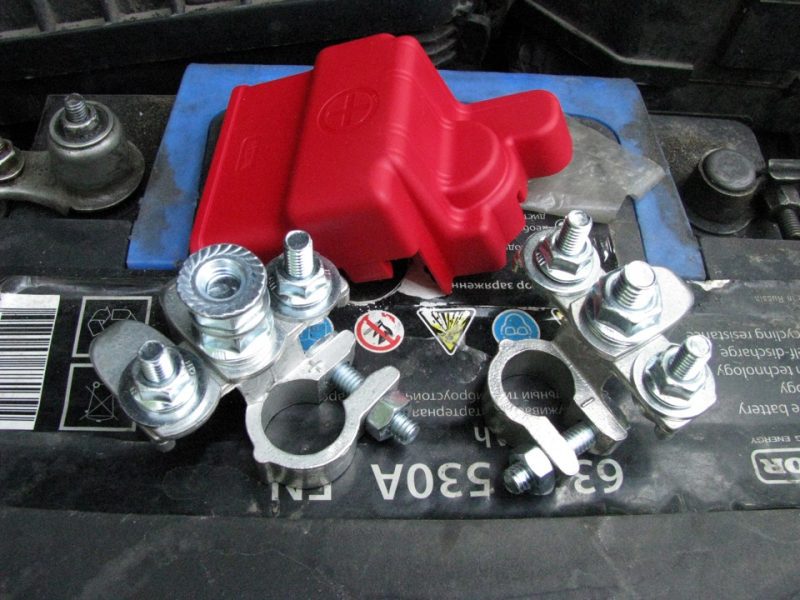

After that, you need to pay attention to the cross-section of the wires and the number of wires connected to the terminal. In the basic configuration of a budget car, there are few such wires (one or two for each terminal), but some equipment may require additional mounting space on the terminal body, which must also be taken into account.
Next, the material of manufacture is selected. This is left to the discretion of the motorist and depends on his material capabilities.
Once the correct terminals have been selected, their connection to the wires depends on the type of product. The safest option is a bolted connection, not a crimp. Before clamping the terminals on the battery down conductors, it is necessary to thoroughly clean the contact surface and, if necessary, remove the protective layer from the inside.
Related videos
In conclusion - a short video about a special type of car terminals that facilitate the procedure for connecting / disconnecting the battery:


Watch this video on YouTube
Questions and answers:
What is the terminal used for? It allows you to quickly and reliably connect the wires. They are used to repair electrical wiring or to connect to devices, for example, to power the system from a battery.
How does the terminal work? The principle is very simple. The terminal body is made of dielectric, and the contact part is made of metal. When wiring is connected to a power source, current is transmitted through the terminal.
What terminal blocks are there? There are two main types: screw and screwless. In the first, the wires are clamped in the housing with a bolt or crimped on a terminal (for example, when connected to a battery), in the second - with a latch.


2 comment
Omar
Hello Sir. Please clarify to me what means car battery layout LS or R S
Thanks.
Omar
Sergiy
Any lubricant has a chemical composition that will eat the battery terminals and plastic, so it is strictly forbidden to lubricate the terminals.